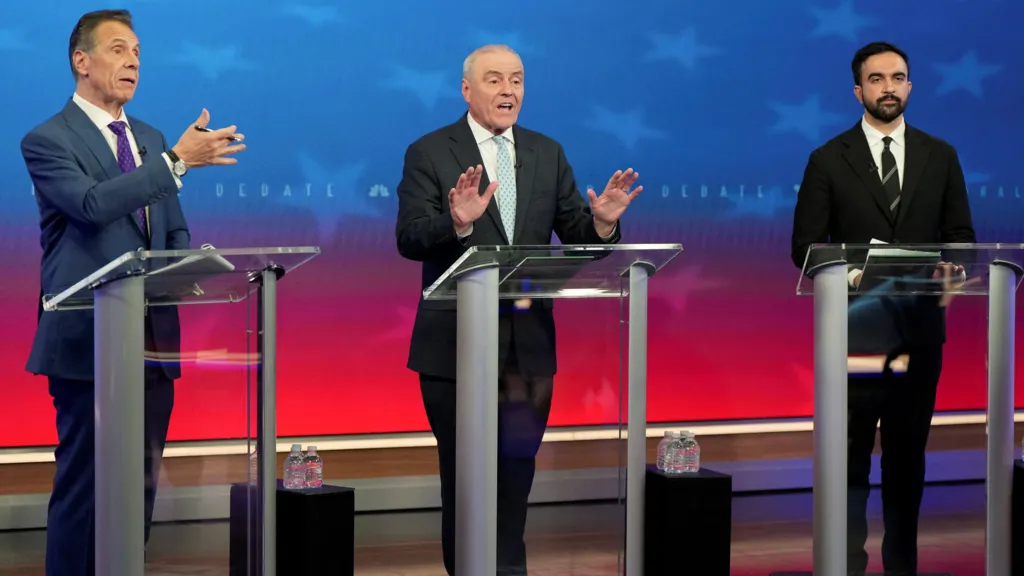Sparks Fly as Candidates Clash Over NYC’s Future
In a contentious and revealing debate, the leading candidates for New York City’s top job clashed over their profoundly different visions for the five boroughs. The October 16th debate provided voters with the clearest contrast yet on critical issues ranging from public safety and the ongoing housing crisis to the city’s economic soul. With the election just weeks away, the fiery exchanges and detailed policy disputes have reshaped the narrative of the race. Here are the five key takeaways from a night that could very well determine the city’s next chapter.
1. Public Safety: A Battle of Philosophies
The most heated moments of the night came during the discussion on crime and public safety. The incumbent mayor doubled down on a platform of strong policing and targeted enforcement, citing recent statistics as proof that a tough-on-crime approach is yielding results. “This is not the time to experiment,” the mayor declared. “This is the time for strength, for order, and for giving our police the tools they need to do their jobs.”
In stark contrast, the challenger offered a vision centered on community investment and addressing the root causes of crime. “We cannot police our way out of this problem,” the challenger argued passionately. “For decades, we’ve poured money into a broken system while starving our communities of mental health services, good jobs, and youth programs. That’s not being soft on crime; that’s being smart on crime.” This fundamental philosophical divide—enforcement versus investment—was the central theme of the night and remains the clearest choice for voters.
2. The Housing Crisis Hits Home
Both candidates agreed that New York is facing an unprecedented housing affordability crisis, but they diverged sharply on the solutions. The debate featured a robust exchange on zoning reform and development. The incumbent advocated for incentivizing private developers to build more housing, including affordable units, through zoning changes and tax abatements. “The only way to solve a supply crisis is with more supply, period. We need to cut the red tape and build,” was the core message.
The challenger, however, attacked this approach as a giveaway to real estate developers, arguing for a massive investment in public and social housing. “We’ve tried trickle-down housing policy, and it’s failed. It’s time for the city to take the lead, to build truly affordable housing for New Yorkers, not luxury condos with a few token affordable units.” The debate laid bare two competing theories on how to solve a problem that affects nearly every resident.
3. Dueling Visions for NYC’s Economy
When the conversation turned to the economy, the candidates’ priorities were clear. The incumbent focused on supporting large corporations and the financial sector, arguing they are the engines of the city’s tax base. The message was one of stability and creating a business-friendly environment to prevent corporate flight. In contrast, the challenger’s pitch was aimed squarely at small businesses and workers, advocating for commercial rent control and stronger worker protections. “The backbone of our city isn’t Wall Street; it’s the pizzeria, the bodega, the dry cleaner in every neighborhood,” the challenger stated, framing the economic debate as Main Street versus Midtown.
4. A Tense Exchange on the Migrant Situation
The ongoing challenge of managing the influx of migrants provided another flashpoint. The incumbent defended the administration’s handling of the situation, emphasizing the need for more federal support while highlighting efforts to provide shelter and services. The challenger, while acknowledging the need for federal aid, criticized the administration for awarding no-bid contracts and for failing to integrate new arrivals into communities more effectively, proposing a more decentralized, community-based approach.
5. Style and Substance: The Final Impression
Beyond policy, the debate was a showcase of contrasting styles. The incumbent appeared as a seasoned, if sometimes defensive, leader managing a complex city. The challenger came across as an energetic and passionate advocate for fundamental change, but at times struggled to answer questions about the specific costs of their ambitious proposals. Ultimately, the debate crystallized the choice before New Yorkers: do they want steady, pragmatic leadership that continues the current path, or a progressive overhaul that promises a profound, if uncertain, transformation of city government? The answer to that question will be delivered on election day.
FAQ
What were the main topics discussed in the NYC mayoral debate?
The main topics were public safety and policing, the housing affordability crisis, economic policy (focusing on big business vs. small business), and the city’s handling of the migrant situation.
What is the core difference between the candidates on the issue of crime?
The incumbent candidate advocates for a strong, enforcement-first policing strategy, while the challenger focuses on a ‘root causes’ approach, prioritizing investment in community services, mental health, and youth programs.
How do the candidates' plans for the housing crisis differ?
The incumbent’s plan relies on incentivizing private developers to build more housing supply through zoning reform. The challenger’s plan focuses on a massive public investment in city-built social and truly affordable housing, criticizing the private-sector approach.


